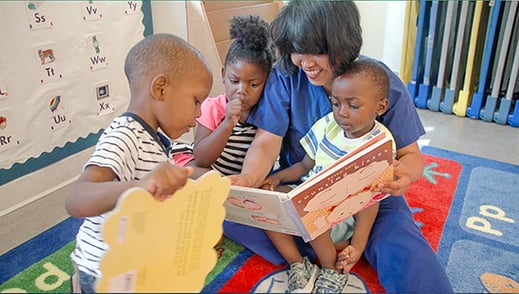

There’s nothing more frustrating for teachers and staff—coaches, directors, and administrators—than to work hard to improve interactions but not see much change in CLASS scores. It seems like that work was for nothing. Or is it just too early to pick up on changes?
We frequently get questions about how long it takes to see improvement in CLASS scores and how much improvement can be expected. Both of these questions depend on several factors:
- What type of professional development are teachers doing?
- How closely is the professional development focused on interactions?
- How intense is it?
- When and how are observations being conducted?
Let’s look at each of these.
Type of Professional Development
We know that professional development is most effective when it increases teachers’ knowledge and then helps them put that knowledge into practice. PD should include some support for a transfer to practice, then: coaching, peer learning communities, or frequent check-ins by the director. Isolated professional development programs, like one-off workshops, are not likely to lead to significant changes.
Focus on Interactions
This may be common sense, but you are most likely to see improvements in interactions if your professional development is closely focused on interactions. More general, quality-improvement-focused PD may not give teachers specific enough help in this area; and, of course, a program focused on some other topic, like implementing a math curriculum, will not necessarily improve interactions unless they are part of the focus. Try to ensure that your goals (more effective interactions) are closely aligned with the PD you provide.
Intensity
The intensity of the PD should be matched to the size of the change you hope to see—and how difficult that change is to make. Want teachers to ask one open-ended question per day? Maybe it’s enough to hang posters and reminders up in each classroom. Want teachers to change the way they approach instructional interactions with children? Something more intense is in order.
When and How Observations are Conducted
Several factors can influence what you observe in a classroom. Looking at the CLASS Technical Appendix (pp. 101-102 in the Pre-K CLASS Manual), you can see that effective interactions fluctuate slightly during the year, with dips around the holidays and toward the summer. If you want to check for gains in effectiveness, it’s best to avoid those periods. In fact, we recommend doing this kind of observation once a year around the same time each year, so you know that you’re comparing apples to apples. This gives you the added benefit of checking whether the teachers’ improvements transfer to a new year and a new group of children.
What Does the Research Say?
Here are a few examples of CLASS score improvements that come from research studies.
- MyTeachingPartner™ Coaching: One-on-one, intensive, CLASS-based coaching, with teachers and coaches meeting every two to four weeks. At the end of one school year, teachers had scores on several CLASS dimensions that were about half a point higher than the control group[1]. These modest gains were enough to show a positive effect on children’s vocabulary scores[2].
- Head Start REDI Program: Weekly mentoring meetings paired with teacher trainings and a new curriculum focused on literacy and social/emotional development. At the end of one school year, teachers had scores on Positive Climate that were just over half a point higher than the control group[3].
- Chicago School Readiness Project: Teacher training, weekly mentoring, and direct child mental health services designed to improve classroom climate and management. At the end of one school year, results showed differences of half a point to nearly one point on several target CLASS dimensions[4].
- Literacy- and CLASS-based Course: A college-style, 14-week course focusing on teacher-child interactions and language and literacy development. Participating teachers showed increases of one-fifth to nearly half a point on CLASS dimensions.
As you can see from these studies, intensive, university-based professional development programs yield effects from about one-fifth to one point over the course of a single school year. It’s no surprise that short-term, less intensive, or less focused PD doesn’t always show effects quickly.
Here are a few final things to consider in planning PD to increase effective teacher-child interactions:
- Get teachers engaged and excited about focusing on interactions. Interactions are really important and can truly change a child’s experiences in care. It is in teachers’ hands to make a difference.
- Create program-wide or center-wide goals for improving interactions. Having shared goals can enhance motivation and help teachers reinforce each other in focusing on interactions.
- Find creative ways to increase the intensity of PD. Start by building knowledge of effective interactions. Then, if coaches can’t meet one-on-one with teachers, set up professional learning communities or lunch break discussions to reinforce the message and help teachers transfer their new knowledge to practice.
Visit the Teachstone website to learn more about professional development options that focus on interactions.
[hr]
Notes
1. Pianta, R. C., Mashburn, A. J., Downer, J. T., Hamre, B. K., & Justice, L. (2008). Effects of web-mediated professional development resources on teacher-child interactions in pre-kindergarten classrooms. Early Childhood Research Quarterly, 23(4), 431–451.
2. Mashburn, A., Downer, J., Hamre, B., Justice, L., & Pianta, R. (2010). Consultation for teachers and children’s language and literacy development during pre-kindergarten. Applied Developmental Science, 14(4), 179–196. doi:10.1080/10888691.2010.516187
3. Domitrovich, C. E., Gest, S. D., Gill, S., Bierman, K. L., Welsh, J. A., & Jones, D. (2008). Fostering high-quality teaching with an enriched curriculum and professional development support: The Head Start REDI program. American Educational Research Journal, 46(2), 567–597. doi:10.3102/0002831208328089
4. Raver, C. C., Jones, S. M., Li-Grining, C. P., Metzger, M., Champion, K. M., & Sardin, L. (2008). Improving preschool classroom processes: Preliminary findings from a randomized trial implemented in Head Start

